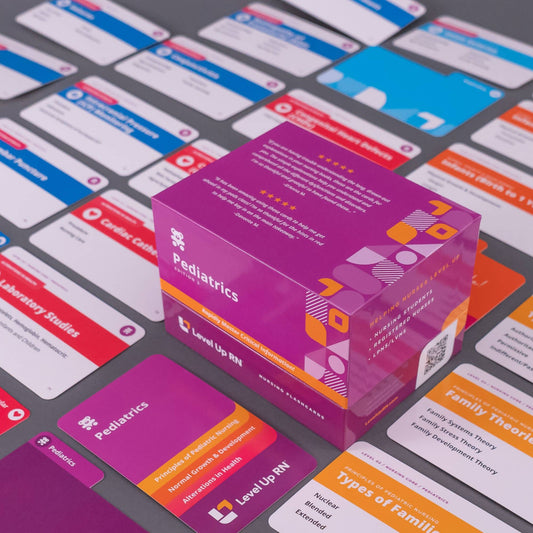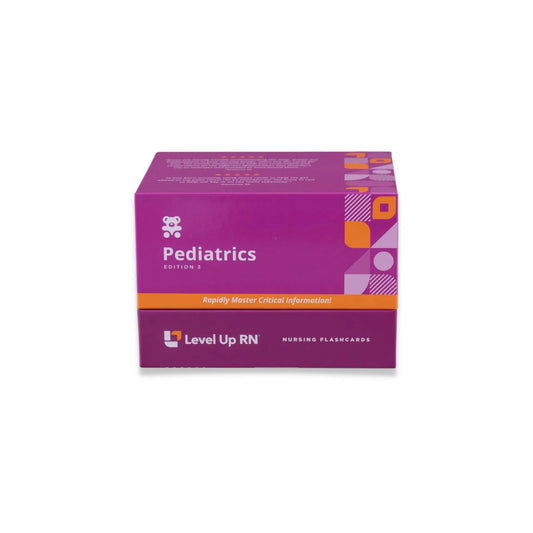Pediatric Nursing - Flashcards
In this article, we discuss parental guidance for those who are caring for infant children, that is, children from birth to one-year of age.
The Pediatric Nursing series follows along with our Pediatric Nursing Flashcards, which are intended to help nurses and nursing students learn and retain information about caring for pediatric patients. The flashcards are a clear, complete study tool and a helpful reference for practicing RNs, PNs, and other medical professionals.
 When you see this Cool Chicken, that indicates one of Cathy's silly mnemonics to help you remember. The Cool Chicken hints in these articles are just a taste of what's available across our Level Up RN Flashcards for nursing students!
When you see this Cool Chicken, that indicates one of Cathy's silly mnemonics to help you remember. The Cool Chicken hints in these articles are just a taste of what's available across our Level Up RN Flashcards for nursing students!
Parental nutrition guidance for infants (birth to one year)
The following are nutrition tips to teach to caregivers of infant children.
Breastmilk or formula
For the first 12 months of life, a child should receive breast milk or formula.
It is important not to prop up a bottle. The caregiver should hold the bottle or, when the child is able, allow the child to hold it on their own.
No supplemental water or other fluids without an order until 6 mos.
Children have a larger percentage of their body make-up composed of water than adults, which means that they are affected by fluid balance disturbances and electrolyte disturbances more than adults. So it is important to educate a new parent or caregiver not to give their infant supplemental water until the age of 6 months, unless advised to do so by a pediatrician.
When preparing formula, although water must be added to it, there is a specific ratio of formula to water. Typically, the ration is one scoop of powdered formula to two ounces of water. It is vitally important to mix water and formula in the correct ratio. If providing baby with liquid formula that is pre-mixed and ready to use after opening, do not add water to it. It is already mixed in the correct ratio.
No honey or cow’s milk until 12 mos.
Do not give honey or cow’s milk to a child until they are one year of age.
Honey should be avoided because of the risk for botulism. Although modern food preservation and preparation standards have essentially eliminated the risk of botulism in adults (whose immune systems are mature), an infant is in the process of building their immune system and might not be able to fend off an infection, which could be life-threatening.
Cow’s milk should be avoided due to the potential for irritation of the infant’s GI tract. Note that some children might need different or special type of formula that includes dairy milk, but this would be per their provider’s orders or instructions.
Introduce solids at 4 – 6 mos.
Solids can be introduced between 4 to 6 months, though, again, defer to any specific guidance of the child’s pediatrician.
Solid foods are introduced at this time when baby has good head control and can sit up with little or no support.
- Start the infant’s solid food diet with iron-fortified infant rice cereal, which is a good transition from a breastmilk or formula diet to solid foods.
- Introduce each new food one at a time, and wait 3 – 5 days between each new food to rule out allergies. Do not alternate between prepared baby foods, such as bananas for one meal, apples for the next, and pears for the next, because if the baby doesn’t tolerate one of these foods (if they have a bad GI reaction or an allergic reaction), it will not be clear which food has caused the issue. That means feeding baby one food at a time, over several days or longer, before moving on to another, different individual food.
- Provide mashed or pureed foods. Infants don’t have many teeth, so they do not yet have the ability to chew their food.
- Introduce common allergens, such as eggs and small tastes of peanut butter, after several foods have been successfully tolerated. There is a lot of guidance at present that allergens should be introduced sooner rather than later to help to prevent the possible development of allergies to a particular food. For example, a pediatrician may say to the parent of a 4-month old, “You don’t have to start feeding her solids, but I want you to take a little bit of peanut butter, put it on your finger, and put it on her lips or her tongue. Do this every day for a couple of weeks to help to prevent an allergy to that food.”
- Introduce soft finger foods at 9 – 10 mos. This is the time when the child is developing their pincer grasp, so they may want to hold their food in their fingers.
- Avoid choking hazards. It is important to avoid choking hazards, for example nuts, seeds, hot dogs, or grapes. Also avoid anything that requires a lot of chewing, like big chunks of meat or cheese.
Parental sleep safety guidance for infants (birth to one year)
 Remember the ABCs of safe sleep: Alone, on their Back, in a Crib!
Remember the ABCs of safe sleep: Alone, on their Back, in a Crib!
Sleep safety is another important thing for caregivers to understand. Parents of infant children should be taught to follow the Cool Chicken hint (ABC) when it comes to putting baby to bed:
- Baby should be alone. It’s okay to share a room with others, but not in the same bed
- Place baby on their back for all sleep, including naps
- Always put baby to bed in a crib, a designated space to sleep that is their own and meets certain safety criteria
Other teachings of sleep safety include the following.
Use a firm, tight-fitting mattress
The mattress in the crib should be firm and fit tightly in the crib frame. This is to prevent baby from getting stuck between the mattress and railing, which could be fatal.
The mattress should only be covered by a fitted sheet. Keep soft bedding such as blankets, pillows, bumper pads, and soft toys out of the baby’s sleep area.
Crib slat spacing
The slats in the crib need to be less than two and three-eighths inches apart from one another (6 cm).
Crib mattress height
Set the crib mattress at its lowest position before baby learns to stand. This will make it harder for them to climb over the rails as baby grows in size and strength.
Remove mobiles
Remove mobiles when the baby is able to get up on their hands and knees, or at 5 mos. old, whichever comes first.
Don’t place crib near a window or heat vent
People get concerned about their child being too cold at night. This leads caregivers to put the crib near a heating vent or window. But overheating is a bigger concern than the infant being too cold. To keep baby warm and not overheated, dress them in pajamas or put them in a sleep sack, which is a blanket that zips up around them. Do not tuck baby in with a blanket that may come loose, as this is a potential choking hazard.
Parental guidance for dental health for infants (birth to one year)
Even for an infant, dental health is important. This is to ensure the health of their teeth when they first erupt.
Schedule first dental appointment at 1 year old
A child should see the dentist at one-year of age or within 6 months of their first tooth erupting, whichever one comes first. For example, if an infant’s first tooth erupts at age 5 months, schedule the dentist appointment for age 11 months. A child whose first tooth doesn’t erupt until they are 9 months old would see the dentist around their first birthday.
Do not start brushing teeth right away
Wipe the baby’s teeth and gums with a damp washcloth before progressing to toothbrushing. This can feel good to the infant and help soothe the gums when baby is teething.
Teething difficulties
For difficulty with teething (e.g., crying, sleeping issues), offer safe teething toys or gently rub baby’s gums with a clean finger. The counterpressure can feel good, which is why babies chew on things when they are teething.
Parental guidance for scheduling infant vaccinations (birth to one year)
The following are guidelines for when to vaccinate infants during their first year.
Vaccinations at birth
 “oKay, you’re Born!”
“oKay, you’re Born!”
These inoculations are given when the baby is born: vitamin K, which is not a vaccine but is an injection of a medication, and hepatitis B.
Vaccinations at 2 mos.
 “B. DR. HIP”
“B. DR. HIP”
This is a mnemonic for the Hep B. (administered between 1 and 2 mos) DTaP, RV, Hib, IPV, and PCV vaccines. RV stands for rotavirus (a virus that causes diarrhea and other intestinal symptoms). Hib is Haemophilus influenzae B. IPV is the polio vaccine. P is for PCV, the pneumonia vaccine.
Vaccinations at 4 mos.
 “DR. HIP”
“DR. HIP”
At 4 months, it is time for another round of DTaP, RV, Hib, IPV, and PCV vaccines.
Vaccinations at 6 mos.
 “B. DR. HIP”
“B. DR. HIP”
At 6 months, it is time for the last round of DTaP, RV, Hib, IPV, and PCV vaccines. Note that it is also time for a round of hepatitis B vaccine (between 6 and 18 mos.). And, if seasonally appropriate, this is the age to start giving children their annual flu shot.


